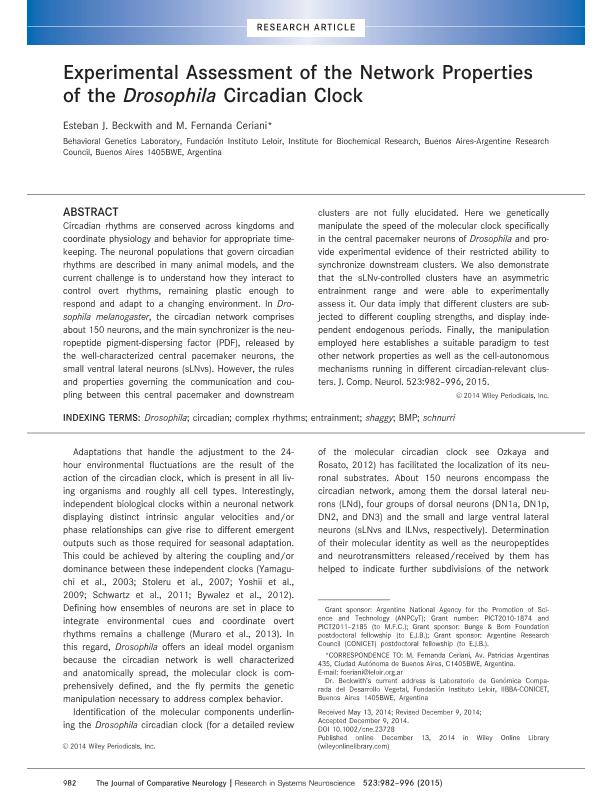Mostrar el registro sencillo del ítem
dc.contributor.author
Beckwith, Esteban Javier

dc.contributor.author
Ceriani, Maria Fernanda

dc.date.available
2017-08-25T21:31:34Z
dc.date.issued
2015-04
dc.identifier.citation
Beckwith, Esteban Javier; Ceriani, Maria Fernanda; Experimental assessment of the network properties of the Drosophila circadian clock; Wiley; Journal Of Comparative Neurology; 523; 6; 4-2015; 982-996
dc.identifier.issn
0021-9967
dc.identifier.uri
http://hdl.handle.net/11336/23063
dc.description.abstract
Circadian rhythms are conserved across kingdoms and coordinate physiology and behavior for appropriate time-keeping. The neuronal populations that govern circadian rhythms are described in many animal models, and the current challenge is to understand how they interact to control overt rhythms, remaining plastic enough to respond and adapt to a changing environment. In Drosophila melanogaster, the circadian network comprises about 150 neurons, and the main synchronizer is the neuropeptide pigment-dispersing factor (PDF), released by the well-characterized central pacemaker neurons, the small ventral lateral neurons (sLNvs). However, the rules and properties governing the communication and coupling between this central pacemaker and downstream clusters are not fully elucidated. Here we genetically manipulate the speed of the molecular clock specifically in the central pacemaker neurons of Drosophila and provide experimental evidence of their restricted ability to synchronize downstream clusters. We also demonstrate that the sLNv-controlled clusters have an asymmetric entrainment range and were able to experimentally assess it. Our data imply that different clusters are subjected to different coupling strengths, and display independent endogenous periods. Finally, the manipulation employed here establishes a suitable paradigm to test other network properties as well as the cell-autonomous mechanisms running in different circadian-relevant clusters.
dc.format
application/pdf
dc.language.iso
eng
dc.publisher
Wiley

dc.rights
info:eu-repo/semantics/openAccess
dc.rights.uri
https://creativecommons.org/licenses/by-nc-sa/2.5/ar/
dc.subject
Drosophila
dc.subject
Circadian
dc.subject
Complex Rhythms
dc.subject
Entrainment
dc.subject.classification
Bioquímica y Biología Molecular

dc.subject.classification
Ciencias Biológicas

dc.subject.classification
CIENCIAS NATURALES Y EXACTAS

dc.title
Experimental assessment of the network properties of the Drosophila circadian clock
dc.type
info:eu-repo/semantics/article
dc.type
info:ar-repo/semantics/artículo
dc.type
info:eu-repo/semantics/publishedVersion
dc.date.updated
2017-08-14T19:56:23Z
dc.identifier.eissn
1096-9861
dc.journal.volume
523
dc.journal.number
6
dc.journal.pagination
982-996
dc.journal.pais
Estados Unidos

dc.journal.ciudad
Hoboken
dc.description.fil
Fil: Beckwith, Esteban Javier. Consejo Nacional de Investigaciones Científicas y Técnicas. Oficina de Coordinación Administrativa Parque Centenario. Instituto de Investigaciones Bioquímicas de Buenos Aires. Fundación Instituto Leloir. Instituto de Investigaciones Bioquímicas de Buenos Aires; Argentina
dc.description.fil
Fil: Ceriani, Maria Fernanda. Consejo Nacional de Investigaciones Científicas y Técnicas. Oficina de Coordinación Administrativa Parque Centenario. Instituto de Investigaciones Bioquímicas de Buenos Aires. Fundación Instituto Leloir. Instituto de Investigaciones Bioquímicas de Buenos Aires; Argentina
dc.journal.title
Journal Of Comparative Neurology

dc.relation.alternativeid
info:eu-repo/semantics/altIdentifier/url/http://onlinelibrary.wiley.com/doi/10.1002/cne.23728/full
dc.relation.alternativeid
info:eu-repo/semantics/altIdentifier/doi/http://dx.doi.org/10.1002/cne.23728
Archivos asociados
